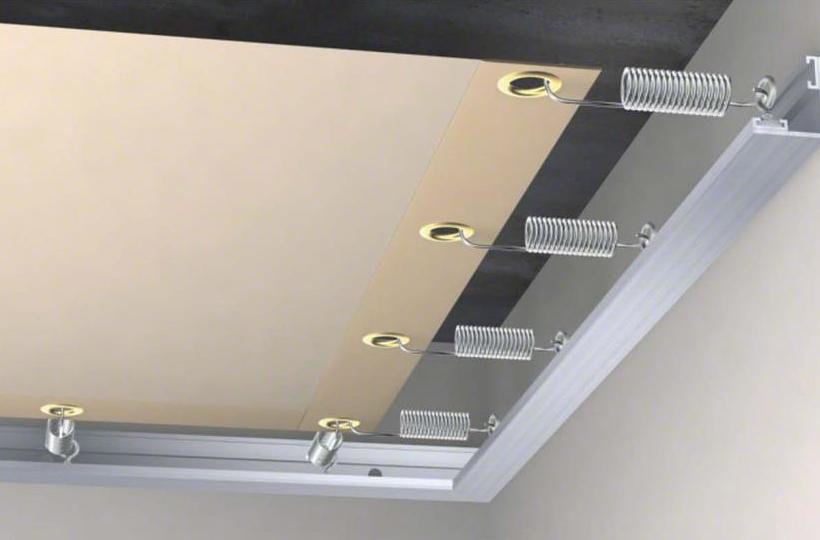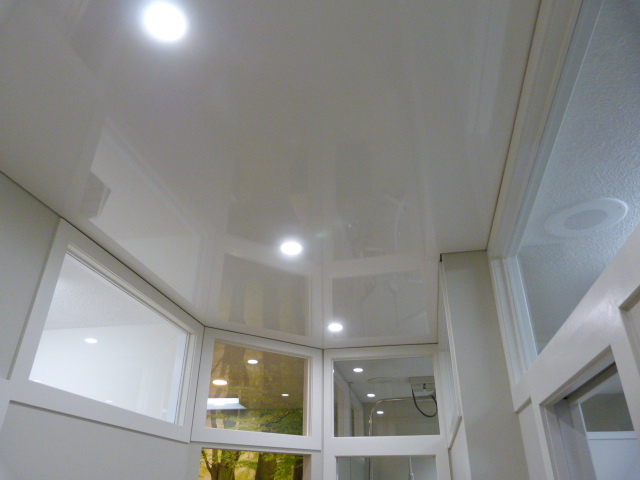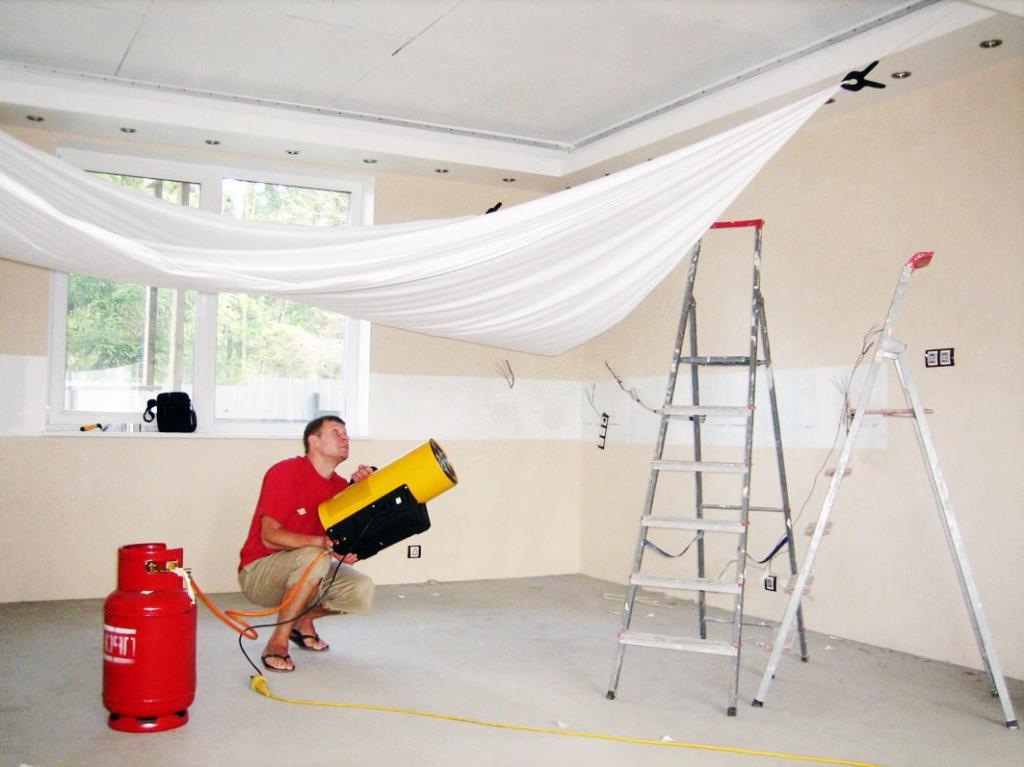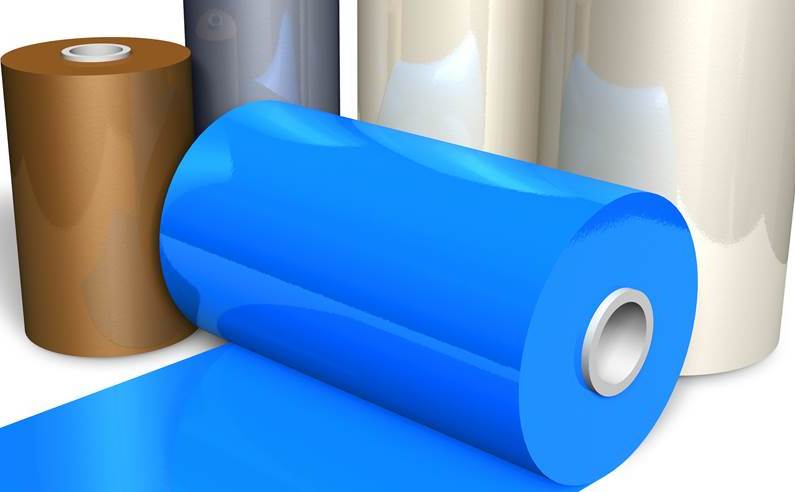In the planning processes for decorating a modern home, the theme of decorating the ceiling less and less often touches on issues of traditional plaster and whitewashing. Even a relatively new method of installing drywall panels is increasingly inferior to the technology of the device of stretch sheets. In this segment, the leading position in the market is occupied by polyvinyl chloride (PVC) materials, but the popularity of fabric ceilings is also growing. It’s not easy to realize such a finish with your own hands, but it is possible if you follow the installation instructions and carefully approach the technological details of the coating.
What is a fabric cloth for the ceiling?
Many people mistakenly believe that fabric fabrics are related to traditional natural materials like cotton, but this is not so. The basis of such coatings is often used polyester with additional impregnations on a polyurethane basis. It is this combination that allows the fabric ceiling, a photo with an example of which is presented above, to compete with technological models of polyvinyl chloride. The difference lies in the surface structure - the fabric has a pronounced texture close to natural canvases. The same PVC looks artificially, although its texture has advantages, including a glossy sheen.
At the same time, one should not generalize the characteristics of fabric cloths. This segment is heterogeneous and contains different coatings that differ in structure, operational properties and the intended method of attachment. For example, German Descor premium fabric ceilings feature a smooth, delicate surface, with some sparkles also being added. On the contrary, the products of the French company Clipso have a pronounced texture and a dense base. The company also produces specialized versions of coatings in which the emphasis is on noise insulation, dirt-repellent and antibacterial qualities. Of course, the presence of specialized properties affects the cost of the product.
Fabric ceiling or PVC coating?
Regarding both types of ceiling coverings, many myths still go around, which can lead to an incorrect product choice. For example, fabric webs are denied moisture resistance, while modern technology for weaving synthetic fibers provides a high degree of tightness of the material. Regarding the invoice, too, not everything is clear. In most cases, neutral fabric ceilings are used, the photo of which is presented below, however, manufacturers note that they can be coated with paint up to 4-6 times throughout the life cycle. By the way, with PVC materials this is not allowed.

Now it’s worth moving on to reliability and environmental safety. The fabric is less hardy and not so effective at holding large loads. Therefore, if priority is given to the ability to prevent a flood from the top floor, then the choice between a PVC ceiling and a fabric stretch fabric will be obvious - the first option holds up to 100 liters of water. In this case, both materials are equally sensitive to the effects of sharp objects. As for environmental safety, then again, both decisions are facing each other - it all depends on the specific synthetic base that is used in both PVC and polyester yarns.
General installation technology
In general, the installation method corresponds to the method of fastening and tensioning PVC materials, but with a simplified scheme. The main technological stages of installation in this case include:
- Taking measurements. The width of the fabric for the ceiling can reach five meters, so you can count on the formation of a uniform seamless coating, even in large rooms with a few exceptions. Moreover, as practice shows, work in rooms with a non-standard layout is simplified.
- Installation of mounting profiles. The most time-consuming and "dirty" part of the entire workflow associated with the installation of supporting equipment (usually a baguette), to which the canvas will be fixed in the future.
- Material fastening. Install fabric ceilings with your own hands without a special tool is quite difficult. Therefore, it is recommended to select clamping devices and accessories for a particular type of profile in advance. This is not so much physically complex as painstaking and highly precise operation.
- Refinement of the coating. Excess web is trimmed and, if possible, the tension force is adjusted. Here we must mention the role of thermal effects on suspended ceilings in principle. In the installation of PVC cloths without a building heat gun, the process is not complete. This operation makes the synthetic material more pliable and prone to stretching. Temperature conditions up to 60 - 70 ° C will provide a similar effect when installing a polyester web.

Preparation for work
Preparatory measures for the installation of a stretch ceiling consist of several stages:
- Marking and measurements. As already mentioned, measurements are performed with the expectation of seamless installation, that is, a single piece of material. In this case, it is necessary to leave a supply of tissue - from 15 to 30 cm, depending on the overall size.
- Preparing the tool for DIY installation. Spatula for fabric ceilings - the main assistant in performing fixing operations. It will allow you to accurately install the coating at the technological points of the baguette.
- Room preparation. If possible, the work area should be freed, as well as paintings and other removable decorative objects that might be damaged during the installation of a stretch ceiling, should be removed from the walls.
- Ceiling surface cleaning. After installing the coating, access to the base will be closed, therefore, even before the implementation of work measures, it is advisable to bring the surface in proper form, as well as take care of the wiring for the lighting system.
As for the materials for installing fabric stretch ceilings with your own hands, the complete set is delivered with the coating on an individual order based on marking data. All necessary accessories are selected in accordance with the project by the direct manufacturer of consumables.
Baguette mounting
Installation of profile elements begins with the rigid fastening of the supporting elements to the walls or to the ceiling. The installation configuration of the baguette is determined by the size of the structure and the area of coverage. Some systems provide dual installation - to the ceiling and wall surface. In each case, a profile of the appropriate destination is applied. Do-it-yourself carrier base for fabric ceilings is mounted with the help of a complete fastening equipment and a screwdriver with a drilling function. Holes for anchor hardware are made in advance, after which the profiles are twisted with bolt fasteners with brackets. It is important to observe the horizontal position of the baguette. This will help the laser level or the usual bubble level.
In the butt joints and corners, the fixation points should be placed as close as possible to the edges of the profiles, but not close - with an indent of 3 cm minimum. If you have to make butt joints in a straight line, then one of the profiles is cut at a 90-degree angle, and the second at a small angle relative to the vertical. Such a junction configuration will provide a more reliable connection, but in principle such connection nodes should be avoided. It is better to use long profile elements with intermediate fixation to the wall or ceiling. If for one reason or another it is not possible to directly attach the load-bearing elements of the fabric ceiling directly to the wall surfaces, then use wooden blocks. They will perform the function of the crate, which will facilitate the installation of anchor joints.
Preparing for fabric mounting
Installation of the canvas is the most critical stage of the whole event, so you should properly prepare for it. Before mounting fabric ceilings in terms of coating fastening, the following conditions must be met:
- Clean the room. This time we are talking about eliminating dirt and dust that could remain after installing the baguette. Especially drilling operations in concrete leave behind large volumes of building fine-grained waste. If possible, it will not be superfluous to dedust profiles, floors and walls with an industrial vacuum cleaner.
- At this point, it is necessary to complete the laying of communication and engineering networks with embedded parts. In addition to the already mentioned lighting system, the installation channels of ventilation, fire sensors, alarms, etc. are thought out in advance. The electrical output for all of these systems can be locked in one box.
- Holes and cracks remaining after mounting the baguette must be sealed. The same applies to technological holes in the walls. For example, ventilation air can become a channel for the passage of dust and moist air, which is unacceptable when installing fabric stretch ceilings. Do-it-yourself patches of such areas can be putty or primer, and the process passages are temporarily closed with a sealed film.
- It is important to provide for temperature regulation in the room. Incandescent ceiling lamps are turned off during installation due to unwanted thermal effects. An exception is LED lamps, which do not emit thermal energy during operation.
Fabric setting
The main task of the installation contractor in this part of the work is to gently clamp the edges of the fabric around the entire perimeter of the room into the baguette profiles. In the design of the latter, appropriate grips should be provided at a distance of 40-50 cm from each other. Fixation should be carried out starting from the middle of the length and gradually move to the corners on each side. At this stage, a spatula for fabric stretch ceilings is just applied. With your own hands, it is necessary to perform a rotary operation in the plane of the slot of the spatula, thereby ensuring the web is rolled into the profile. Corner places are still free - they will be given special attention.

The result of the main dressing should be uniform fixation of the fabric around the perimeter without wrinkles and wrinkles. Again, if necessary, you can connect the thermal effect, softening too hard material. To do this, use a building hair dryer, holding it at a distance of 10-15 cm from the working surface. Heating is carried out in the process of making circular motions with the working head over the entire area of the fabric ceiling. In the reviews of stretch fabric webs, he notes that this material is sensitive to thermal effects, so the hairdryer should be set to minimum power. Otherwise, melted or yellowed areas may remain on the ceiling surface. The successful completion of the operation will be indicated by the absence of wrinkles and wrinkles in the stretched coating.
Technique for processing complex attachment areas
After installing the base, there are still a number of incomplete assembly sections, which must be given special attention:
- The transition of tissue from a larger volume to a smaller one. An incision is made at the inner corner, in which a piece of tissue with a smaller volume is distributed and fixed. This applies to uneven sections with additional connection nodes.
- Outside corner processing. For such nodes, special fittings in the profile are provided. For example, Deskor fabric ceilings include additional accessories that allow filling to the corner along the straight sides of the joint, closing a small gap of the seam from above.
- The transition of the ceiling at different levels. From the point of view of the structural device, the implementation of such a system will not cause particular difficulties. With the help of mounting profiles, a superstructure of the frame is made with additional fixing elements. But what about the fabric transition? The bend is formed using the lining - unlike the components of the baguette, such panels can be made of aluminum or plastic. There is no point in providing rigidity from the side of the patch - the main thing is to keep the shape of the tissue transition from one level to another.
- The connection of tissue within the framework area. If it is not possible to use a single piece of canvas to cover the entire room due to the layout, you will have to make intermediate connections. They are implemented on the same principle as the joints in the clamps. Only for their design it will be necessary at the stage of installation of the supporting structure to install lines of profiles with grips along the contours where the weld is supposed to be made.
Fabric Ceiling Care
Such coatings are not afraid of water, so wet care is possible, but with certain rules. The surface can be washed with napkins and rags, but with a mild effect. Firstly, do not use coarse abrasive devices for cleaning like brushes, and secondly, it is advisable to refuse from aggressive cleaning chemicals. Minor impurities can also be removed with a dry, clean cloth, and stagnant or oily stains can be removed with window cleaners, polish or ammonia. In general, in the context of care features, you can recall the choice of the type of stretch coating: PVC or fabric ceiling? The first option in this regard is more practical, since the structure of polyvinyl chloride in itself is more resistant to pollution. Its outer protective film repels soot and grease, so PVC ceilings are often used in the kitchen in areas with hoods. These are the advantages of a glossy surface over a rough fabric structure with fibers, and the aesthetic advantages of polyester will matter in comparison with the criteria of design value.

Conclusion
Stretch ceilings allow you to beautifully decorate the top of the room without a radical invasion of the interior design. There are some functional advantages of such coatings, but they are limited due to the features of the used paintings. For example, unlike suspended structures with drywall, in this case, it will not be possible to mount pipes or thick communication routes into a niche of the frame. If we compare this solution with traditional finishing methods, the main drawback will be the price. For example, the best fabric ceilings from manufacturers of the Descor and Clipso level cost 2000 - 2500 rubles / m2. Models with photo printing will cost the same. Do the operational benefits of stretch fabric justify such an investment? According to reviews, decorative properties are well worth these costs, and taking into account the physical and mechanical qualities, you can count on long-term use and savings on repair activities for several years.